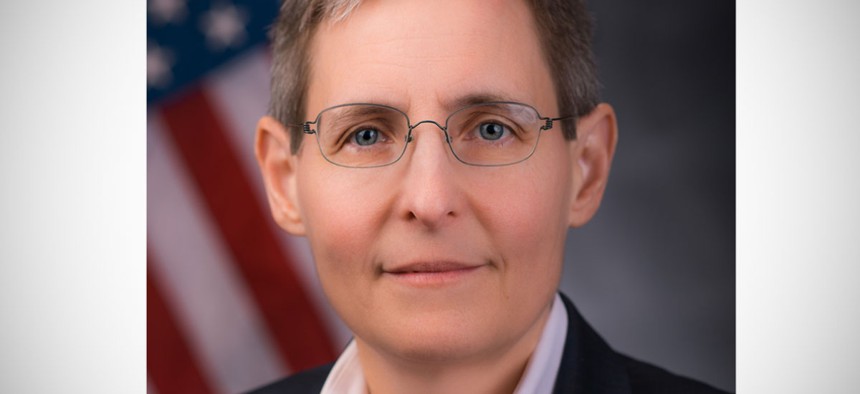EPA CIO Wants her Tech Team to Take Smart Risks

EPA
Though she left private industry six years ago, Ann Dunkin is still evangelizing agile practices -- and encouraging her staff to take risks.
The Environmental Protection Agency’s Chief Information Officer Ann Dunkin bid farewell to the private sector more than six years ago. But her decades-long career there left its mark.
Today, she’s still preaching the benefits of agile and nimble practices to her employees and encouraging them to take risks -- albeit a very specific type of risk.
“We tell them, 'We don't want you to take stupid risks; we want you to take smart, carefully thought-out risks,’” Dunkin says in a recent interview with Nextgov.
Federal agency technology projects are slow. But they are made even slower amid the rapid pace of 21st-century technological innovation. The combination has strained efficiency and effectiveness in the federal IT sector.
Dunkin is one of the key federal tech employees who is working to incorporate best practices from the private sector to improve the situation.
Introducing Agile
The agency is attempting to transition into a model that incorporates agile practices into its daily work, according to Dunkin, such as incremental development and new contracting principles.
“We have lots and lots of great people in government who have resigned themselves to the idea that everything takes a long time,” Dunkin says. “So we're working very hard to recreate the sense of urgency that everything doesn't have to take a long time, and that the passage of time matters.”
In April, she hired 18F’s Executive Director Greg Godbout to lead EPA's digital services team.
He’s helped to get their colleagues excited about agile and innovative approaches to doing work, according to Dunkin. Although they both are on board with the new agile direction EPA wants to move in, Godbout can really rally troops, Dunkin says. “He’s way better at it than I am," she says.
They are still in the early stages of incorporating agile practices into projects. The E-Enterprise for the Environment portal is one of the first. The website is expected to act as a central location for businesses and citizens to find information and tools related to EPA’s programs.
“We're planning to deliver the first phase of the portal for the enterprise relatively soon,” Dunkin says.
From California to the Capitol
Dunkin had been leading IT programs at the Palo Alto Unified School District for about five years when she got a phone call from Washington.
“The classic joke is, it's sort of hard to ignore when the White House calls,” Dunkin says. “So when I got a phone call from the Presidential Personnel Office about whether I'd like to come work for the government, it was hard to say no.”
Years ago, she’d handed over her resume to the Gay & Lesbian Victory Institute’s Presidential Appointments Project, which helps funnel LGBT individuals into positions in the federal government. But she hadn't heard anything.
The White House was then looking to build a slate of potential agency CIO candidates for President Barack Obama’s second term, Dunkin recalls. After a wave of meetings with the office and various federal agencies, she received her first job offer -- from EPA.
“That was great because that was the place I was really excited about going to work,” she says.
In February, she officially made the switch from managing IT for a single school district to being charged with it for an entire federal agency with nearly 16,000 employees and a $8 billion budget.
The switch meant taking on a much bigger portfolio. But it also meant potentially having a much greater impact, she says.
“In Palo Alto, I was able to make the contributions to one school district in one state, but here I can move IT forward for the entire agency across the country,” Dunkin says.
Her path to public service began in 2008. After 20 years with Hewlett-Packard, she was working as the senior research and development program manager. But she wanted a change. Her career in the Palo Alto school system -- first as technology director, then as chief technology officer -- provided just that.
She was responsible for the district’s entire IT infrastructure, including classroom computers and mobile devices, and technology tools for staff and libraries.
Lesson No. 1: Know Which Rules Can be Changed
Soon after starting her work at the federal government, Dunkin made a crucial discovery. Even the agency’s rules, regulations and agency folkways don’t necessarily have to stifle innovation.
Each of EPA’s rules is meant to ensure the agency operates correctly and fairly, Dunkin says. But the rules can also make it much more difficult for staff to launch effective projects in an efficient time frame.
The trick, she says, is to understand which rules are laws, and which are simply agency policies that can be adapted if necessary. Sometimes, when she’s inquired as to the purpose of a specific practice, Dunkin says the response she would receive was, "Well, we always did it that way."
“Understanding the difference between a policy someone in an agency made and a law that you can't change, at least not quickly, are really important distinctions,” Dunkin says.
NEXT STORY: 18F Official: We Have Benefits Facebook Doesn't


